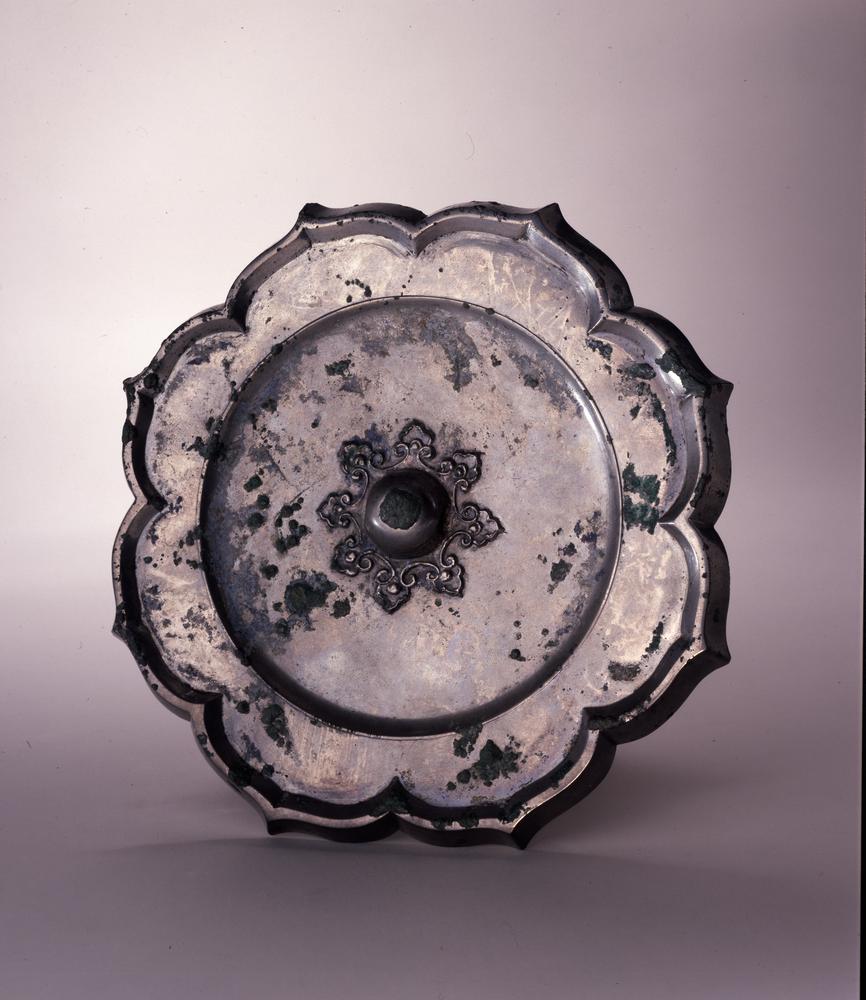Period:Tang dynasty Production date:9thC
Materials:silk, 絲綢 (Chinese),
Technique:painted
Subjects:buddha equestrian musician palace/mansion 佛 (Chinese) 哺乳動物 (Chinese) 樂獅 (Chinese) 皇城 (Chinese) life of the buddha
Dimensions:Height: 50 centimetres Width: 20 centimetres
Description:
Painted banner with two scenes from the Life of the Buddha, with a black cartouche beside each. The top scene shows the pleasures of life in the palace: Śākyamuni seated with wife Yasodhara, watching musicians. The bottom scene shows the departure of Śākyamuni on horseback above the palace. Ink and colour on silk.
IMG
![图片[1]-banner; painting; 幡(Chinese); 繪畫(Chinese) BM-1919-0101-0.98-China Archive](https://chinaarchive.net/Tang dynasty/Paintings/mid_00000123_001.jpg)
![图片[2]-banner; painting; 幡(Chinese); 繪畫(Chinese) BM-1919-0101-0.98-China Archive](https://chinaarchive.net/Tang dynasty/Paintings/mid_RFC711.jpg)
Comments:EnglishFrom Whitfield 1982:This banner consists of two scenes only, each as usual accompanied by a cartouche, left blank. Although it displays no great sophistication, the depiction is engagingly direct, and not without a touch of humour.At the top, Sākyamuni is seen seated on a dais in the centre, with his wife Yasodharā in the side verandah. Before them is a dancer, in Chinese costume with long sleeves and cloud-toed shoes, accompanied by musicians and two kneeling figures. The scene represents Sākyamuni’s life of pleasure in his father’s palace, while that below shows his departure by night. This scene takes place between the walls of the palace. Guards can be seen in front, carrying banners; other banners seen over the upper wall indicate the presence of more guards, and two are within the walls. All wear scale armour, and all save the one in the gateway make the gesture of cupping one hand to their ear, to catch the sound of the unseen departure. One indeed is seen stretched out as if asleep, but still making this gesture. Above the palace Sākyamuni rides his horse, each hoof supported by a kneeling figure to muffle the sound. The scene marks Sākyamuni’s departure from the palace to the life of austerities and would probably have been followed by a farewell scene with his horse and groom, as in Pls. 29 and 38. ChineseFrom Whitfield 1982:此幡僅包括兩個場景,每個按慣例有一個長方形題簽,但沒有文字。沒有運用很複雜的手法,表現質樸,並且還有些許的幽默。在上部,可以看見太子端坐在中央的講臺上,他的妻子耶輪陀羅在旁邊的走廊裏,在他們前面是一個舞者,穿著中國服飾,長長的衣袖,腳尖繡著雲彩的舞鞋,還有伴有一群樂師和兩個跪著的人,這個場景表現太子在父親王宮中的歡愉生活。下面的畫面表現他的深夜出走,這個場景發生在宮牆之間,前面可以看見衛兵,擡著幡,宮牆之上還能看見旗,暗示還有更多的衛兵,其中兩人在牆中間。他們全部穿著鱗片狀的甲胄,留下一人在門口,其他的衛士一手捂住耳朵,以捕捉看不見的出走的聲音,其中一個直躺在地上好像已經睡著了,但仍然保持著這個姿勢。在宮殿以上,太子騎著他的馬,每個馬蹄都被一個跪著的人托著以消音。這個場景標志著太子從王宮向苦修生活的轉變,也許還應該接繼上與他的坐騎和馬夫告別的場景,正如圖29和圖38中所見的那樣。
Materials:silk, 絲綢 (Chinese),
Technique:painted
Subjects:buddha equestrian musician palace/mansion 佛 (Chinese) 哺乳動物 (Chinese) 樂獅 (Chinese) 皇城 (Chinese) life of the buddha
Dimensions:Height: 50 centimetres Width: 20 centimetres
Description:
Painted banner with two scenes from the Life of the Buddha, with a black cartouche beside each. The top scene shows the pleasures of life in the palace: Śākyamuni seated with wife Yasodhara, watching musicians. The bottom scene shows the departure of Śākyamuni on horseback above the palace. Ink and colour on silk.
IMG
![图片[1]-banner; painting; 幡(Chinese); 繪畫(Chinese) BM-1919-0101-0.98-China Archive](https://chinaarchive.net/Tang dynasty/Paintings/mid_00000123_001.jpg)
![图片[2]-banner; painting; 幡(Chinese); 繪畫(Chinese) BM-1919-0101-0.98-China Archive](https://chinaarchive.net/Tang dynasty/Paintings/mid_RFC711.jpg)
Comments:EnglishFrom Whitfield 1982:This banner consists of two scenes only, each as usual accompanied by a cartouche, left blank. Although it displays no great sophistication, the depiction is engagingly direct, and not without a touch of humour.At the top, Sākyamuni is seen seated on a dais in the centre, with his wife Yasodharā in the side verandah. Before them is a dancer, in Chinese costume with long sleeves and cloud-toed shoes, accompanied by musicians and two kneeling figures. The scene represents Sākyamuni’s life of pleasure in his father’s palace, while that below shows his departure by night. This scene takes place between the walls of the palace. Guards can be seen in front, carrying banners; other banners seen over the upper wall indicate the presence of more guards, and two are within the walls. All wear scale armour, and all save the one in the gateway make the gesture of cupping one hand to their ear, to catch the sound of the unseen departure. One indeed is seen stretched out as if asleep, but still making this gesture. Above the palace Sākyamuni rides his horse, each hoof supported by a kneeling figure to muffle the sound. The scene marks Sākyamuni’s departure from the palace to the life of austerities and would probably have been followed by a farewell scene with his horse and groom, as in Pls. 29 and 38. ChineseFrom Whitfield 1982:此幡僅包括兩個場景,每個按慣例有一個長方形題簽,但沒有文字。沒有運用很複雜的手法,表現質樸,並且還有些許的幽默。在上部,可以看見太子端坐在中央的講臺上,他的妻子耶輪陀羅在旁邊的走廊裏,在他們前面是一個舞者,穿著中國服飾,長長的衣袖,腳尖繡著雲彩的舞鞋,還有伴有一群樂師和兩個跪著的人,這個場景表現太子在父親王宮中的歡愉生活。下面的畫面表現他的深夜出走,這個場景發生在宮牆之間,前面可以看見衛兵,擡著幡,宮牆之上還能看見旗,暗示還有更多的衛兵,其中兩人在牆中間。他們全部穿著鱗片狀的甲胄,留下一人在門口,其他的衛士一手捂住耳朵,以捕捉看不見的出走的聲音,其中一個直躺在地上好像已經睡著了,但仍然保持著這個姿勢。在宮殿以上,太子騎著他的馬,每個馬蹄都被一個跪著的人托著以消音。這個場景標志著太子從王宮向苦修生活的轉變,也許還應該接繼上與他的坐騎和馬夫告別的場景,正如圖29和圖38中所見的那樣。
© Copyright
The copyright of the article belongs to the author, please keep the original link for reprinting.
THE END
![[Qing Dynasty] British female painter—Elizabeth Keith, using woodblock prints to record China from the late Qing Dynasty to the early Republic of China—1915-China Archive](https://chinaarchive.net/wp-content/uploads/2022/11/image-191x300.png)




